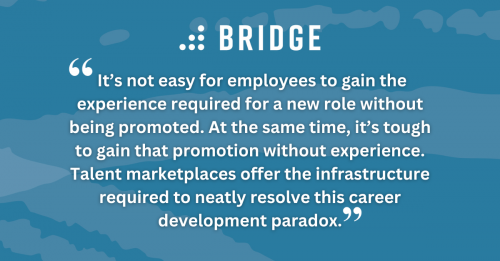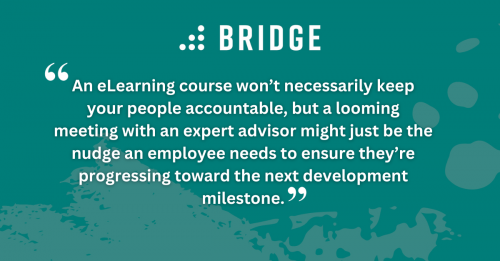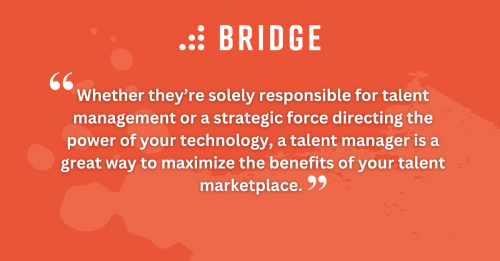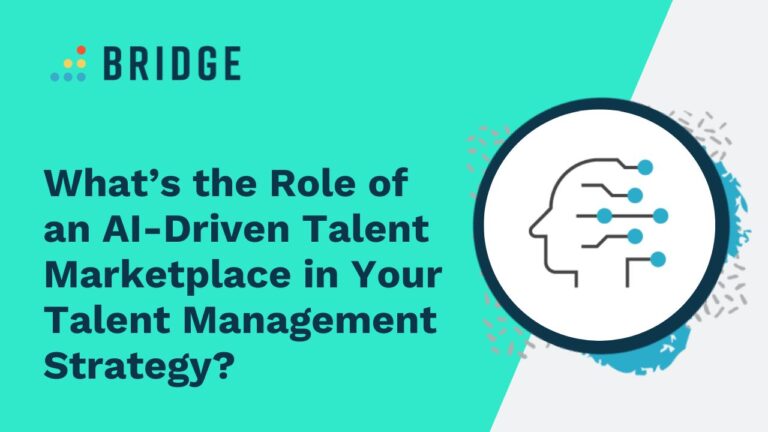Business and HR leaders always enjoy a good challenge, and the task of filling vacant positions with skilled and qualified candidates provides plenty to keep them going. Research suggests that 69% of US-based organizations entered 2023 with a skills gap to address. This isn’t an insoluble problem, however—and, with the right tools and a good attitude toward employee development, you might find the solution lies in your own workforce.
In some ways, this is a counter-intuitive idea. After all, skills gaps come about when your employees (and the labor market as a whole) don’t have the skills you need.
With a talent management strategy and a talent marketplace on hand, however, you’ll be equipped to provide your people with the training, experience, mentors, and job opportunities necessary for continuous upskilling and reskilling.
Why a Talent Marketplace Is the Keystone of Your Talent Management Strategy
Talent management is all about developing your people to be as productive and engaged as possible, and it’s a strategy comprising several components.
Arguably one of the most important components is internal mobility. Internal mobility ensures that employees can move to different roles and departments, allowing you to fill any skills gaps with people who can hit the ground running faster than a new hire.
Without a talent marketplace, however, your people may struggle to locate vacant positions. Or, even if they stumble across an attractive-looking opportunity, they might lack ways to identify and access the training and experience required to qualify them for the role. In fact, they may even lack the insight they need to recognize when an opportunity aligns with their career aspirations!
A talent marketplace breathes life into internal mobility programs. It gives employees all the practical tools they need to confidently navigate your internal vacancies and it ensures that their aspirations and your need for skilled workers are addressed in one fell swoop. So, what does a talent marketplace look like?
KEEP READING | ‘What Is Talent Mobility? Plus, What It’s Not!’
What Is a Talent Marketplace?
A talent marketplace is a digital platform that provides employees with career opportunities within your organization.
Taking a narrow view, it might be tempting to assume that ‘talent marketplace’ is just a new way to describe a jobs board—but that’s far from the full story. The opportunities a talent marketplace offers don’t just include new roles, but a wealth of available mentors, recommended learning resources, and gig-based projects designed to prepare your people for the next stage of their careers.
All of these resources—alongside any job opportunities that may be available—will be tailored to the aspirations of each individual employee, and built around the skills those aspirations require.
MORE ABOUT MOBILITY | ‘The 5 Pillars of a Successful Talent Mobility Strategy and How to Leverage Them’
4 Key Features of a Talent Marketplace
We all know that career progression is rarely achieved in a single step. It’s not just about identifying an appealing career path, but about gaining relevant skills and experience along the way. In turn, these steps can’t be taken without the right training and development resources to hand.
That’s why talent marketplaces offer a number of different features designed to help your people navigate possible career paths within your organization—whether they’re looking to rocket upwards or take a lateral step in an exciting new direction.
Though no two talent marketplaces will be identical, we’ve picked out four features that a good talent marketplace can’t do without.
1) Tailored Learning Recommendations
Learning is the lynchpin of any professional development plan. It’s one of the best ways to acquire the knowledge and skills that justify career advancement, and it’s also an essential means of keeping on top of new trends, technologies, and best practices.
While these are intuitive observations—we all know learning is going to help us gain new skills—that knowledge doesn’t necessarily make it any easier to find learning resources that are relevant to your employees’ aspirations.
In fact, organizations that boast an impressive learning library comprising thousands of courses can be particularly vulnerable to this problem. After all, working out exactly which skills are on offer within each and every course is a time-consuming task. Plus, even when courses are correctly tagged with the skills in question, employees still need to know which skills they’re looking for. That’s not always straightforward, especially if they’re looking to pivot toward a new and potentially unfamiliar line of work.
A good talent marketplace can resolve all of these problems with a little algorithmic intervention. Boosted by AI, a talent marketplace can automatically assess learning content and tag courses with the skills they teach. A good talent platform will also have a handle on each employee’s existing skills, alongside the ones they want to learn. On top of that, your marketplace should also be able to infer which new skills are required for a given career.
By drawing this data together, talent marketplaces should be able to effortlessly recommend relevant courses to any employee who’s provided their job title, industry, and ideal career path, ensuring that no learning opportunities are left uncovered on the search for the next skill.

2) Short-Term Project Work
Learning is an essential way to develop new skills, but learning doesn’t happen solely within your LMS. In fact, academic research suggests that some of the most effective learning strategies involve “converting practice into understanding” through experience.
It’s not easy for employees to gain the experience required for a new role without being promoted (or, in the case of a lateral move, without working in the field in question). At the same time, it’s tough to gain that promotion without experience. Talent marketplaces offer the infrastructure required to neatly resolve this career development paradox while also lending your teams an extra helping hand.
By logging into your talent marketplace platform, your employees will be able to access postings for short-term projects or gigs, allowing them to put their learning to practice and gain on-the-job experience in roles that represent the next step of their career journeys.
This is a real win-win scenario for both ambitious workers and overstretched teams. Remember: one employee’s extraneous task is another employee’s career stepping stone!

3) Mentorship Opportunities
Practical experience in a given skill or role is fantastic for career development, but there’s no reason to leave it at that. Gigs allow workers to experience a slice of life in a different role, but for more expansive guidance on what their next step might look like, there’s no better resource than a mentor.
In fact, as academic literature suggests, mentorship doesn’t just have positive implications for mentee outcomes—it’s also a fantastic way to cultivate knowledge, inspiration, and creative performance among your mentors.
Mentorship isn’t just about advice, either. It’s also a great way to keep your people on track to achieving their career goals. An eLearning course won’t necessarily keep your people accountable, but a looming meeting with an expert advisor might just be the nudge an employee needs to ensure they’re progressing toward the next development milestone.
Through a talent marketplace, your people will be able to see available mentors, including details like their roles, availability, and skills. This is particularly handy for those employees looking to make a lateral move into a different field, since (by definition!) they’re less likely to meet a relevant mentor figure without a mediating platform.
LEARN ABOUT MENTORING | ‘How Org Charts Can Help Workplace Mentorship Programs’
4) Internal Job Opportunities
In some ways, internal job opportunities are the main attraction of a talent marketplace. They’re the reason employees gain skills and experience through learning, gigs, and mentorship—and if they don’t represent the final destination of an employee’s career path, they’re undoubtedly a sizable stretch of road along the way.
With the right data to back it up, a good talent marketplace will be able to identify and suggest job opportunities that fit employee aspirations, displaying the skills required for the role in order to quickly determine which of your people are best suited to it. This process will leave your organization in a position to quickly fill important positions with eminently qualified individuals.

Staffing for Talent Mobility
Today’s talent marketplaces are largely defined by increasingly automated features, as recommendations for learning, projects, mentorships, and opportunities are handled by sophisticated AI algorithms. A talent mobility manager, however, will allow you to enhance your system with a human touch. Automation might be central to your day-to-day operations, but these AI interventions primarily empower talent managers to focus on high-level tasks—they don’t provide the strategic heading for your program.
Talent managers may, for example, spend their time creating a culture of learning and development within your organization, encouraging employee buy-in for your talent marketplace while working with HR leaders to ensure the marketplace supports your overarching HR strategy.
Alternatively, they could focus on the technical side of your talent marketplace by working with IT teams to make sure the marketplace is properly implemented and regularly maintained.
Whether they’re solely responsible for talent management or a strategic force directing the power of your technology, a talent manager is a great way to maximize the benefits of your talent marketplace.
Get the Comprehensive Guide to Talent Marketplaces
For a rundown on the extensive benefits of talent marketplaces, coupled with an overview of the AI-augmented developments animating the field, check out our full ebook: ‘How AI Can Power Talent Management’.




